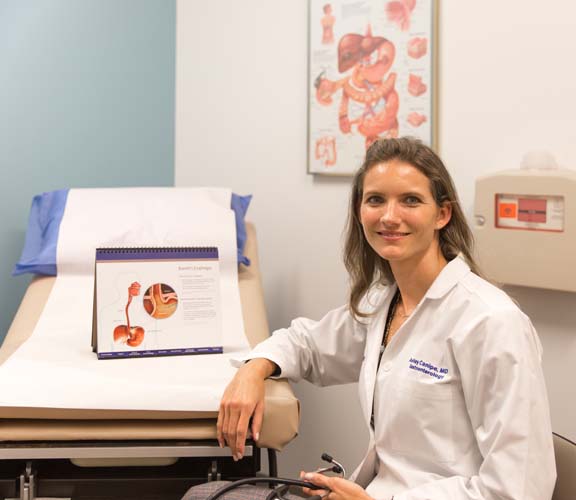
Now that ground has been broken on the new Scully Endoscopy Center at the Indian River Medical Center, gastroenterologist Dr. Ashley Canipe is working on a task that’s every bit as time consuming as laying the brick and troweling the mortar.
Canipe is in the midst of equipping the new center with the high-tech equipment it will need to give patients at the Vero facility the best possible care and treatment.
It’s an odd shopping list that includes “tables” you wouldn’t want to eat off of, things that go “boom” in the day (or the night), a type of “image streaming” that no one on Netflix would be likely to order, as well as a piped-in carbon dioxide system.
Specifically, Canipe is focusing her attention on the center’s new interventional endoscopy/pulmonary suite. And while she stops short of admitting to being a full-fledged “techie,” she does say “usually people who do interventional endoscopy [like me] are drawn to the newer technologies because that is a lot of what’s involved in what we do.”
With the volume of endoscopic procedure performed at IRMC increasing, in Canipe’s words, “exponentially over the past couple of years,” lining up the proper equipment for the new endoscopy center is a top priority.
The language of gastroenterology tech toys is often a language of acronyms from ERCPs (endoscopic retrograde cholangiopancreatography) and MRCPs (magnetic resonance cholangiopancreatography) to ROSE (rapid on-site evaluation) equipment and video GIEs (gastro-intestinal endoscopies).
Fortunately it’s a language Canipe speaks fluently.
“We want to make this [suite] a state-of-the-art interventional GI and pulmonary room that’s comparable to any major academic center, and a tertiary care center,” says Canipe.
First on her list is a fixed fluoroscopy or real-time projection X-ray imaging unit to replace the current portable versions now in use. The image resolutions on the current portable units, according to Canipe, are “nowhere near as good” as what’s available from the newer fixed fluoroscopy units.
Canipe adds there have even been times when the portable units have been wheeled off to other parts of the hospital, leaving the endoscopy team with no available fluoroscopes. Bolted to the floor, the new unit won’t wander off to parts unknown.
Then there’s that table you probably wouldn’t want to eat off.
“We’re also getting a new fluoroscopy table,” exclaims Canipe, “which is a huge improvement from the stretcher we’re using right now. Capable of tilting in all different directions while the patient lies on top of it, the new table will allow Canipe and her colleagues to better manipulate the angles and direction of their scans.
Next there’s the “boom” – or cleaning up the cable clutter.
“Everything,” says Canipe, “will be hanging from the walls and able to be moved, based on hydraulics, up, down, sideways [which will] get everything off the floor. Right now, there are literally wires everywhere and we have trouble lining up our monitors and everything we need to because of how cluttered the floor is with all the different wires.”
In other words, in the new suite all those cables and wires will be off the floor and suspended overhead, creating what Canipe says will be “a more reliable, versatile and safe work space with boom technology.”
Next on Canipe’s list is an in-room cytology station.
Cytology is the study of individual tissue cells. Currently once a tissue sample is taken, Canipe says, hospital pathologists have to wheel in “a little cart that has a microscope on it” to examine the samples and provide the aforementioned “rapid on-site evaluation.”
The new suite will have a built-in cytology workstation and the ability to stream those images directly to monitors where proceduralists like Canipe can view them in real time. It’s not what most folks would call “must-see TV,” but to Canipe and fellow GI physicians Dr. Charles Eberhart, Dr. Bruce Grossman, Dr. Joseph Zerega and Dr. Gregory MacKay, it will a big improvement.
Then there’s that carbon dioxide thing.
CO2, according to Canipe, is better than oxygen at insufflating (inflating) the stomach or other areas of the gastro-intestinal tract she and her colleagues need to examine.
According to Canipe, CO2 is “much safer and patients have less gas and bloating after a procedure,” but currently that gas is stored in large tanks inside the suite which she admits “is probably not the safest or the best idea.”
In the new suite, says Canipe, “CO2 will be piped in, just like the anesthesia gases,” and accessed from an outlet in the overhead booms: “That, I think, is a huge improvement.”
Add upgrading endoscopes and upgrading gastroscopes and it’s clear the overall “scope” of Canipe’s mission means she’ll likely be at this project until early 2018 when the new Scully Endoscopy Center is slated to open.
For more information, call the IRMC endoscopy center at 772-299-3511.



